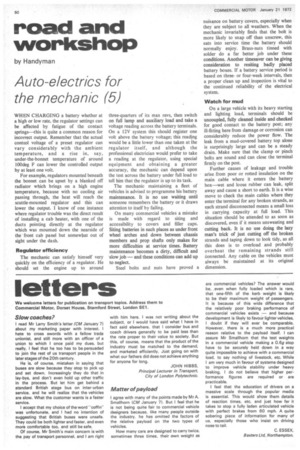road and workshop
Page 52

If you've noticed an error in this article please click here to report it so we can fix it.
by Handyman
Auto-electrics for the mechanic (5)
WHEN CHARGING a battery whether at a high or low rate, the regulator settings can be affected by fatigue of the contact springs—this is quite a common reason for incorrect output. Remember that the actual contml voltage of a preset regulator can vary considerably with the ambient temperature, and a rise in, say, under-the-bonnet temperature of around 100deg F can lower the controlled output by at least one volt.
For example, regulators mounted beneath the bonnet can be upset by a blanked off radiator which brings on a high engine temperature, because with no cooling air passing through, the heat will reach the scuttle-mounted regulator and this can lower the output. I know of one instance where regulator trouble was the direct result of installing a cab heater, with one of the ducts pointing directly at the regulator which was mounted down the nearside of the front cab panel but somewhat out of sight under the dash.
Regulator efficiency The mechanic can satisfy himself very quickly on the efficiency of a regulator. He should set the engine up to around
three-quarters of its max revs, then switch on full lamp and auxiliary load and take a voltage reading across the battery terminals. On a 12V system this should register one volt above the battery voltage; this reading would be a little lower than one taken at the regulator itself, and although the professional electrician would prefer to take a reading at the regulator, using special equipment and obtaining a greater accuracy, the mechanic can depend upon the test across the battery under full load to tell him that the regulator is up to its task.
The mechanic maintaining a fleet of vehicles is advised to programme his battery maintenance. It is no use waiting until someone remembers the battery or it draws attention to itself by failing.
On many commercial vehicles a mistake is made with regard to siting and accessibility to covers and filler caps. Siting batteries in such places as under front wheel arches and down between chassis members and prop shafts only makes for more difficulties at service times. Battery maintenance becomes a dirty, difficult and 'slow job — and these conditions can add up to neglect.
Steel bolts and nuts have proved a nuisance on battery covers, especially when they are subject to all weathers. When the mechanic invariably finds that the bolt is more likely to snap off than unscrew, this eats into service time the battery should normally enjoy. Brass-nuts tinned with solder do a far better job under these conditions. Another timesaver can be giving consideration to resiting badly placed battery boxes. If a battery service period is based on threeor four-week intervals, then a proper clean up and inspection is vital to the continued reliability of the electrical system.
Watch for mud On a large vehicle with its heavy starting and lighting load, terminals should be uncoupled, fully cleaned inside and checked for good contact to the battery post; any ill-fitting here from damage or corrosion can considerably reduce the power flow. The leak from a mud-covered battery top alone is surprisingly large and can be a steady drain. Make sure that the clamp or pinch bolts are sound and can close the terminal firmly on the post.
Further causes of leakage and trouble arise from poor or rotted insulation on the main cable where it enters the battery box—wet and loose rubber can leak, split away and cause a short to earth. It is a wise move to check the main cables where they enter the terminal for any broken strands, as each strand disconnected means a small loss in carrying capacity at full load. This situation should be attended to as soon as discovered, even if it means unsweating and cutting back. It is no use doing the lazy man's trick of just cutting off the broken strands and taping down to look tidy, as all this does is to overload and probably overheat the remaining strands still Connected. Any cable on the vehicles must always be maintained at its original dimension.










































































































